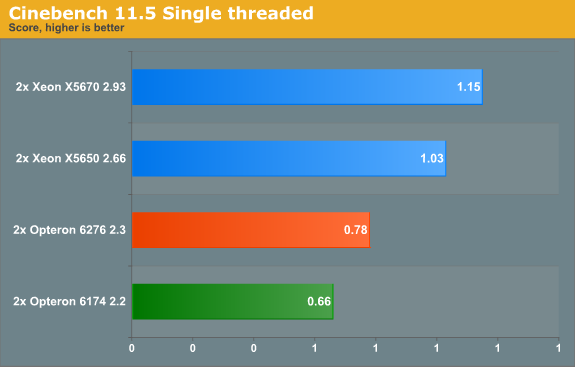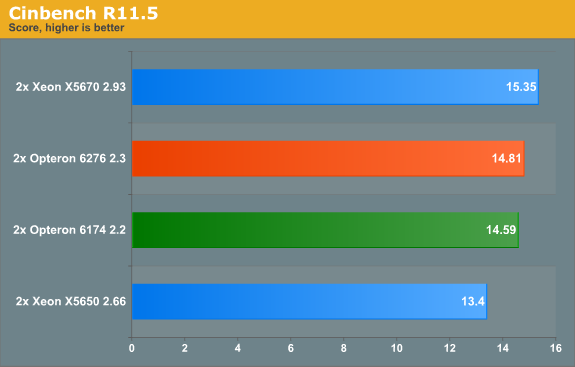Bulldozer for Servers: Testing AMD's "Interlagos" Opteron 6200 Series
by Johan De Gelas on November 15, 2011 5:09 PM ESTRendering Performance: Cinebench
Cinebench, based on MAXON's software CINEMA 4D, is probably one of the most popular benchmarks around, and it is pretty easy to perform this benchmark on your own home machine. The benchmark supports 64 threads, more than enough for our 24- and 32-thread test servers. First we tested single-threaded performance, to evaluate the performance of each core.

Single-threaded performance is relatively poor when you do not enable Turbo Core: with that setting the Opteron 6276 scores only 0.57. So the single-threaded FP performance is about 10% lower, probably a result of the higher FP/SSE latencies of the Interlagos FPU. However, the 6276 Opteron can boost the clock speed to 3.2GHz. This 39% clock speed boost leads to a 37% (!) performance boost. The difference with the older "Istanbul" based Opteron "Magny-cours" 61xx can only get larger once software with support for the powerful FMAC and AVX capable units is available. Also newer compilers will take the longer FP latencies into account and will probably boost performance by a few percent even without using FMAC or AVX.
Before we look at the Multi-threaded benchmark, Andreas Stiller, the legendary German C't Journalist ("Processor Whispers") sent me this comment:
"You should be aware that Cinebench 11.5 is using Intel openMP (libguide40.dll), which does not support AMD-NUMA"
So while Cinebench is a valid bench as quite a few people use the Intel OpenMP libraries, it is not representative of all render engines. In fact, Cinebench probably only represent the smaller part of the market that uses the Intel OpenMP API. On dual CPU systems, the Opteron machines run a bit slower than they should; on quad CPU systems, this lack of "AMD NUMA" awareness will have a larger impact.

We did not expect that the latest Opteron would outperform the previous one by a large margin. Cinebench is limited by SSE processing power. The ICC 11.0 compiler was the fastest compiler of its time for SSE/FP intensive software, even for the Opterons (up to 24% faster than the competing compilers), but it has no knowledge of newer architectures. And of course, the intel compiler does favor the Xeons.
The Opteron 6200 has a total of eight dual issue (if you count only those pipes that do calculations) FPUs, while the Opteron 6100 has a total of 12 dual issue FPUs. The only advantage that the 6200 has (if you do not use the FMAC or AVX capabilities) is that it can interleave two FP threads on one module. So you get 16 FP threads that can dispatch one FP per clock versus 12 FP threads that can dispatch two FP per clock. That capability is especially handy when your threads are blocked by memory accesses. This is hardly the case in Cinebench (but it is probably the reason why Interlagos does so well in some HPC tests) and as a result, the Opteron 6276 cannot pull away from the Opteron 6174.
Anand reported that the best Core i7 (2600K, 4 cores/8 threads, 3.4GHz) achieves 6.86. So considering that a dual Opteron 6200 is cheaper than the dual Xeon, and more manageable than two workstations, such a renderfarm may make some sense.










106 Comments
View All Comments
veri745 - Tuesday, November 15, 2011 - link
Shouldn't there be 8 x 2MB L2 for Interlagos instead of just 4x?ClagMaster - Tuesday, November 15, 2011 - link
A core this complex in my opinion has not been optimized to its fullest potential.Expect better performance when AMD introduces later steppings of this core with regard to power consumption and higher clock frequencies.
I have seen this in earlier AMD and Intel Cores, this new core will be the same.
C300fans - Tuesday, November 15, 2011 - link
1x i7 3960x or 2x Interlagos 6272? It is up to you. Money cow.tech6 - Tuesday, November 15, 2011 - link
We have a bunch of 6100 in our data center and the performance has been disappointing. They do no better in single thread performance than old 73xx series Xeons. While this is OK for non-interactive stuff, it really isn't good enough for much else. These results just seem to confirm that the Bulldozer series of processors is over-hyped and that AMD is in danger of becoming irrelevant in the server, mobile and desktop market.mino - Wednesday, November 16, 2011 - link
Actually, for interactive stuff (read VDI/Citrix/containers) core counts rule the roost.duploxxx - Thursday, November 17, 2011 - link
this is exactly what should be fixed now with the turbo when set correct, btw the 73xx series were not that bad on single thread performance, it was wide scale virtualization and IO throughput which was awefull one these systems.alpha754293 - Tuesday, November 15, 2011 - link
"Let us first discuss the virtualization scene, the most important market." Yea, I don't know about that.Considering that they've already shipped like some half-a-million cores to the leading supercomputers of the world; where some of them are doing major processor upgrades with this new release; I wouldn't necessarily say that it's the most IMPORTANT market. Important, yes. But MOST important...I dunno.
Looking forward to more HPC benchmark results.
Also, you might have to play with thread schedule/process affinity (masks) to make it work right.
See the Techreport article.
JohanAnandtech - Thursday, November 17, 2011 - link
Are you talking about the Euler3D benchmark?And yes, by any metric (revenue, servers sold) the virtualization market is the most important one for servers. Depending on the report 60 to 80% of the servers are bought to be virtualized.
alpha754293 - Tuesday, November 15, 2011 - link
Folks: chip-multithreading (CMT) is nothing new.I would explain it this way: it is the physical, hardware manifestation of simultaneous multi-threading (SMT). Intel's HTT is SMT.
IBM's POWER (since I think as early as POWER4), Sun/Oracle/UltraDense's Niagara (UltraSPARC T-series), maybe even some of the older Crays were all CMT. (Don't quote me on the Crays though. MIPS died before CMT came out. API WOULD have had it probably IF there had been an EV8).
But the way I see it - remember what a CPU IS: it's a glorified calculator. Nothing else/more.
So, if it can't calculate, then it doesn't really do much good. (And I've yet to see an entirely integer-only program).
Doing integer math is fairly easy and straightforward. Doing floating-point math is a LOT harder. If you check the power consumption while solving a linear algebra equation using Gauss elimination (parallelized or using multiple instances of the solver); I can guarantee you that you will consume more power than if you were trying to run VMs.
So the way I see it, if a CPU is a glorified calculator, then a "core" is where/whatever the FPU is. Everything else is just ancillary and that point.
mino - Wednesday, November 16, 2011 - link
1) Power is NOT CMT, it allways was a VERY(even by RISC standards) wide SMT design.2) Niagara is NOT a CMT. It is interleaved multipthreading with SMT on top.
Bulldozer indeed IS a first of its kind. With all the associated advantages(future scaling) and disadvantages(alfa version).
There is a nice debate somewhere on cpu.arch groups from the original author(think 1990's) of the CMT concept.